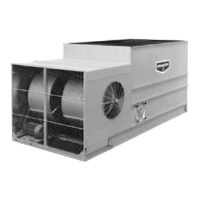20
Operation and Maintenance Instructions
Cleaning of Stainless Steel
Routine Maintenance – Mild Cleaning
Simple pressure washing (of sheet metal components only), using household cleaners, detergents or ammonia annually
(more frequently in marine or industrial environments) will help maintain the finish and keep it free of atmospheric
contaminants.
Minor Surface Dirt – Mildly Aggressive Cleaning
Use of a sponge or bristle brush with a non-abrasive cleaner is recommended. After cleaning, rinse with warm water from a
hose or pressure washer. Towel dry cleaned area and coat area with a high quality wax to provide extra protection.
More Aggressive Cleaning – Removal of Fingerprints or Grease
Repeat processes 1 and 2, then use a hydro-carbon solvent like Acetone or alcohol. As with any hydro-carbon solvent,
caution must be taken when using the product. Do not use in confined spaces or while smoking. Keep solvents out of
contact with hands and skin. Household glass cleaner, Spic nʼ Span are other options for cleaners. After cleaning, towel dry
and apply a coat of high quality wax for extra protection.
Aggressive Cleaning – Removing Stains or Light Rust
If iron contamination or surface staining is suspected, immediately remove the stain or rust using a chrome, brass or silver
cleaner. The use of mild non-scratching creams and polishes are also recommended. When the cleaning procedure is
complete; use a high quality wax for extra protection.
Most Aggressive Cleaning – Removing Heavy Rust Deposits, Iron Contamination, Spot Weld Discoloration and
Weld Spatter using Acid
First try processes 1 through 4. If the stain or rust is not removed, the following should be used as a last resort. Rinse the
surface with hot water. Use a saturated solution of oxalic or phosphoric acid (10 to 15% acid solution). This should be
applied with a soft cloth and allowed to stand for a few minutes – do not rub. This acid should etch out the iron particles.
Follow this with an ammonia and water rinse. Rinse the surface again with hot water; coat with a high quality wax for added
protection. Use extreme caution when working with acids! Synthetic rubber gloves should be used, goggles and aprons are
advisable.
DO NOT USE THIS METHOD IF THE UNIT HAS GALVANIZED STEEL COMPONENTS.
As a minimum, these guidelines should be followed to maintain and clean the stainless steel unit. When cleaning stainless steel,
NEVER use coarse abrasives or steel wool, NEVER clean with mineral acids and NEVER leave stainless in contact with iron or
carbon steel.
For more information on cleaning stainless steel, please request a copy of EVAPCOʼS Engineering Bulletin 40.
For more information on choosing the appropriate grade of stainless steel, please request a copy of EVAPCO's Engineering Bulletin 46.
Cold Weather Operation
EVAPCO counterflow evaporative cooling equipment is well suited to operate in cold weather conditions. The counterflow cooling
tower design encases the heat transfer media (fill) completely and protects it from the outside elements such as wind which can
cause freezing in the unit.
When the evaporative cooling unit is going to be used during cold weather conditions, several items need to be considered. These
include: unit layout, unit piping, unit accessories, and capacity control of the units.
Unit Layout
Adequate unobstructed air flow must be provided for both the intake and discharge from the unit. It is imperative that the equipment
minimize the risk of recirculation. Recirculation can result in condensation freezing the inlet louvers, fans and fan screens. The
buildup of ice on these areas can adversely affect air flow and in more severe cases, lead to failure of these components.
Prevailing winds can create icing conditions on the inlet louvers and fan screens adversely affecting airflow to the unit.
For additional information on unit layout, please refer to EVAPCOʼs Equipment Layout Manual.

